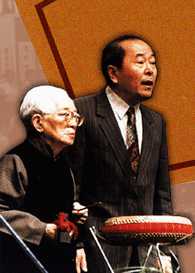
Ping Opera grew out of Lianhualao, which was popular in Eastern
Hebei Province and became popular in
Tianjin in Guangxu Period, Qing Dynasty. In 1915, a Lianhualao troupe led by Cheng Zhaocai and Yue Mingzhu came to Tianjin and won success at their first performance in Yanle Teahouse (now Hongqi Theater). This opera originated from people and from its tune to content all cater to the taste of Tianjin citizens, so it developed quickly here and Tianjin became its sourceland. When Ping Opera became prosperous in Tianjin, the Kun Storytelling Houses around Houjiahou, Nanshi and Hebei Avenue all invited Ping actors and actresses to perform there. In this way, Ping Opera became even more popular. From 1915 to 1930's, the Ping troupes in Tianjin amounted to dozens and its climax came. A group of out standing Ping actresses including Liu Cuixia, Bai Yushuang, Ai Lianjun, Hua Yulan, etc. emerged. It plays an important role in the development of Chinese Ping Opera.
After 1949, Tianjin Ping Opera Stage took on a new look and many new plays welcomed by the masses emerged, such as "Liu Qiao'er", "Liu Hulan", "Sister-in-law
Xianglin", etc. In 1953, Tianjin Ping Opera Troupe was established. In 1958, Tianjin Ping Opera Institute was set up. At the same time, some traditional plays appeared again on the stage after renovation. After 1979, some new plays such as "Two Chaste Girls", "Regret in Dagu", and the prize-winning "Willow in the South of the Village". There are now Tianjin Ping Opera Institute (governing two troupes), Jixian County Ping Opera Troupe, Baodi County Ping Opera Troupe, Jinghai County Ping Opera Troupe, Ninghe County Ping Opera Troupe and Hangu Ping Opera Troupe, altogether 7 troupes. Now, Ping Opera is still very popular in Tianjin.